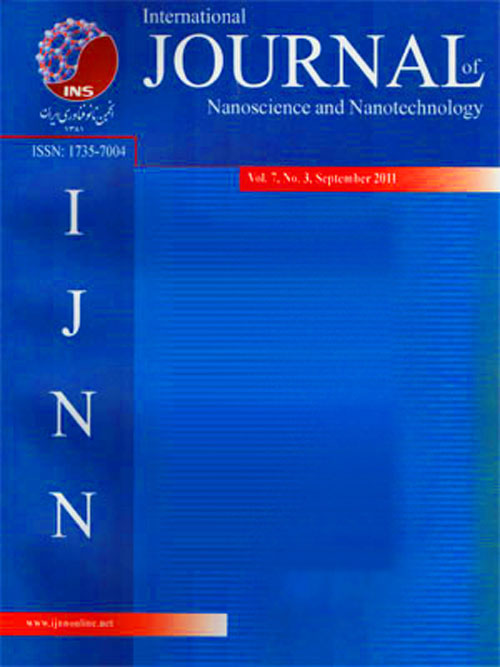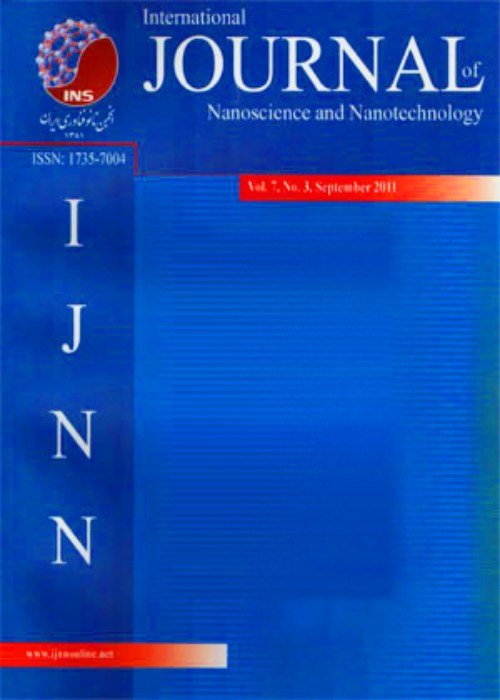فهرست مطالب

International Journal Of Nanoscience and Nanotechnology
Volume:10 Issue: 4, Autumn 2014
- تاریخ انتشار: 1393/10/12
- تعداد عناوین: 7
-
-
Pages 197-203Nanosilica periodic acid (nano-SPIA) is found to be a new, powerful, and reusable heterogeneous catalyst for the rapid synthesis of 2-naphtholazo dyes via diazotization of aromatic amines and followsazo coupling with 2-naphthol under solvent-free conditions at room temperature by grinding. Eco-friendly, heterogeneous reaction conditions, high stability of diazonium salt, simple experimental procedures, and high yields are some of the important advantages of this method.Keywords: Nanosilica periodic acid, Azo dye, Diazonium salt, 2, naphthol, Solvent free
-
Pages 205-214V-shaped and triangular cantilevers are widely employed in atomic force microscope (AFM) imaging techniques due to their stability. For the design of vibration control systems of AFM cantilevers which utilize patched piezo actuators, obtaining an accurate system model is indispensable prior to acquiring the information related to natural modes. A general differential quadrature element method (GDQEM) analysis based on layer-wise displacement beam theory was performed to obtain the natural frequencies of V-shaped AFM cantilevers with piezoelectric actuators. A finite element analysis was applied to validate the accuracy of numerical results. Finally, a parametric investigation of the sensitivity of natural frequencies with respect to beam geometry was performed. Simulations show that presented approach is considerably accurate and does not need a lot computational costs. Based on the governing equations, general differential quadrature method (GDQM) and GDQM could be applied for uniform and stepped plates, respectively. Thus, presented approach covers the V-shaped and triangular cantilevers perfectly and could be utilized to derive the dynamic response of such systems with a little substitution.Keywords: V, shaped cantilever, Atomic force microscope (AFM), GDQEM
-
Pages 215-222In this article, commercially pure copper samples were severely deformed by equal channel angular pressing (ECAP) up to eight passes at room temperature. The effects of severe plastic deformation on the microstructure, mechanical properties, and electrical conductivity of the copper were investigated. The microstructure evolution was followed by optical microscope and field emission scanning electron microscope (FE-SEM). FE-SEM shows the extreme evolution of the microstructure after four to eight ECAP passes, in which a large amount of nanoscale and ultrafine grains are observable. The mechanical properties of the pure copper in each pass were studied by compression testing and Brinell hardness method at room temperature. In this respect, hardness and yield stress increased by ~390 MPa and 75HB, respectively, after five-pass ECAP because of finer boundary spacing. The electrical conductivity measurement at room temperature showed that there was no significant change in the conductivity of the processed samples compared with the initial specimen. Hence, by applying ECAP, one can obtain the ultrafine pure copper with sub-micro-meter grain sizes that can improve mechanical properties without impairing the electrical conductivity.Keywords: Equal channel angular pressing, Electrical conductivity, Grain refinement, Mechanical properties, Ultrafine grains
-
Pages 223-236It has been recently shown that manufacturing p-n-junctions, field-effect and bipolar transistors, thyristors in a multilayer structure by diffusion or ion implantation with the optimization of dopant and/or radiation defects leads to increase the sharpness of p-n-junctions (both single p-n-junctions and p-n-junctions framework their system). Due to the optimization, one can also obtain increasing of homogeneity of dopant in doped area. In this paper, we consider manufacturing of a field-effect heterotransistor without p-njunction. Framework the approach of manufacturing, we consider a heterostructure with specific configuration, doping required parts of the heterostructure by dopant diffusion or by ion implantation and optimization of annealing of dopant and/or radiation defects. The optimization gives us possibility to decrease dimensions of field-effect transistors. We introduce an analytical approach to model technological processes without crosslinking concentrations of dopant and radiation defects on interfaces between layers of heterostructure.Keywords: Field, effect transistors, Decreasing of dimensions of transistors, Analytical approach to model transistors, Optimization of technological process
-
Pages 237-244In the present work, graphene was synthesized by chemical vapor deposition (CVD) method. The structure of graphene was then confirmed by X-Ray diffraction (XRD) and scanning electron microscope (TEM) images. After that, mixed acid method (H2SO4/HNO3) was used to make the structure of synthesized graphenehydrophilic. In this method, carboxylate and hydroxide groups were linked to the edges of graphenenano sheets. The hydrophilic graphene was added to ethylene glycol (EG) with the concentrations of 0.100, 0.125, and 0.150 wt%, and the mixtures were sonicated at 60°C for 3hours to prepare the ethylene glycol/ graphenenano fluid. The thermal conductivity of samples was measured by KD2, while thermophysical properties of were estimated by valid theoretical equations. Then heat transfer coefficient of the samples was measured by using a straight pipe under constant heat flux and a turbulent flow regime. According to the obtained results, thermal conductivity and heat transfer coefficient increased by 21.2% and 42.4%, respectively, only by the addition of 0.15wt % of graphene in to ethylene glycol. Also thermal conductivity and heat transfer coefficient were improved by increasing the temperature and concentration of graphene.Keywords: Graphene, nanofluid, Ethylene glycol, Thermal Conductivity, Heat transfer coefficient, Turbulent flow
-
Pages 245-256Nanocomposite composed of organoclay(Cloisite 20A-C20A) and Poly lactic acid (PLA) was prepared by solvent casting method. Physical, mechanical, thermal, barrier and microstructure properties of the composite were studied. X-Ray diffraction (XRD) patterns and scanning electron microscopy (SEM) images revealed that the diffraction peak of nanoclay shifted to lower angles and the d-spacing between the C20A layers increased. The formation of an intercalated structure with good compatibility and homogeneously dispersed nanoparticles was observed. Tensile strength (TS) and elastic modulus (E-M) of PLA/C20A nanocomposites increased significantly with clay concentrations, while the values of elongation (E) percentage decreased dramatically. Glass transition temperature (Tg) and degree of crystallinity (%) were determined by DSC (Differential Scanning Calorimetry). The presence of C20A provoked significant raise in both the Tg and the degree of crystallinity. The water vapor permeability (WVP) of the nanocomposites compared to pure PLA moved down by approximately 12-50% by adding 3-7 wt% C20A. An atomic force microscopy (AFM) was applied to evaluate the surface morphology and roughness of PLA films. Pure PLA possessed smoother surfaces and a lower roughness parameter (Sa). New composite based on PLA and C20A could prove to be an improved biopolymer with better functional properties for packaging and other applications.Keywords: Nanocomposite, Nanoparticle, Functional properties, PLA, Packaging
-
Pages 257-261Magnetic nanoparticles can bind to different drug delivery systems and can be used for drug targeting to a specific organ by using an external magnetic field as well as used in hyperthermia by heating in alternating magnetic fields. The characteristics of iron oxide nanoparticles are significantly affected by particle size, shape and zeta potential, among which the particle size plays the most important role. In this study, a chemometric approach was applied for the optimization of iron oxide nanoparticle size. To optimize the size of nanoparticles, the effect of three experimental parameters on size was investigated by means of multivariant analysis for which Fe 2+/Fe3+ ratio, pH and ionic strength of the media were considered. The experiments were performed on the basis of the Box-Behenken experimental design. The obtained regression model was characterized by both descriptive and predictive abilities (R2 = 1). The method was optimized with respect to Z average diameter as a response. The Box-Behenken experimental design provides optimality in optimizing and testing the robustness of iron oxide nanoparticles preparation method.Keywords: Box, Behenken design, Iron oxide, Nanoparticles, Optimization


